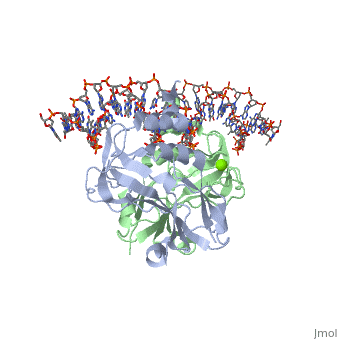1h6f
From Proteopedia
Human TBX3, a transcription factor responsible for ulnar-mammary syndrome, bound to a palindromic DNA site
Structural highlights
DiseaseTBX3_HUMAN Ulnar-mammary syndrome. The disease is caused by variants affecting the gene represented in this entry. FunctionTBX3_HUMAN Transcriptional repressor involved in developmental processes (PubMed:10468588). Binds to the palindromic T site 5'-TTCACACCTAGGTGTGAA-3' DNA sequence, or a half-site, which are present in the regulatory region of several genes (PubMed:12000749). Probably plays a role in limb pattern formation (PubMed:10468588). Required for mammary placode induction, and maintenance of the mammary buds during development (By similarity). Involved in branching morphogenesis in both developing lungs and adult mammary glands, via negative modulation of target genes; acting redundantly with TBX2 (By similarity). Required, together with TBX2, to maintain cell proliferation in the embryonic lung mesenchyme; perhaps acting downstream of SHH, BMP and TGFbeta signaling (By similarity). Involved in modulating early inner ear development, acting independently of, and also redundantly with, TBX2 in different subregions of the developing ear (By similarity). Acts as a negative regulator of PML function in cellular senescence (PubMed:22002537).[UniProtKB:P70324][1] [2] [3] Evolutionary ConservationCheck, as determined by ConSurfDB. You may read the explanation of the method and the full data available from ConSurf. Publication Abstract from PubMedT-box genes encode transcription factors involved in morphogenesis and organogenesis of vertebrates and invertebrates. Mutations in human T-box genes TBX3, TBX5, and TBX1 cause severe genetic disorders known as Ulnar-Mammary syndrome (UMS), Holt-Oram syndrome (HOS), and DiGeorge syndrome, respectively. The crystal structure of the T-box domain of the first human T-box transcription factor, TBX3, in complex with DNA at 1.7 A resolution explains structural consequences of T-box domain point mutations observed in UMS and HOS patients. Comparison with the structure of the T-box domain from Xenopus laevis (Xbra) bound to DNA shows differences in several secondary structure elements and in the quaternary structure of the two complexes. TBX3 independently recognizes the two binding sites present in the palindromic DNA duplex, whereas in Xbra, binding to the palindrome is stabilized through interactions between the two monomers. The different quaternary structures suggest different DNA binding modes for T-box transcription factors. Structure of the DNA-bound T-box domain of human TBX3, a transcription factor responsible for ulnar-mammary syndrome.,Coll M, Seidman JG, Muller CW Structure. 2002 Mar;10(3):343-56. PMID:12005433[4] From MEDLINE®/PubMed®, a database of the U.S. National Library of Medicine. See AlsoReferences
| ||||||||||||||||||||


